Text
Feminism, Intersectionality and Stereotypes
I have learned a lot this semester that has opened my eyes to feminism and mainly intersectionality. Feminism is the movement for social, political, and economic equality between women and men. Globally feminism is not only concerned with direct laws that discriminate against women, but also social structures and the denial of equal opportunity. This is a current issue still going on throughout the world, women are not treated equally than men around the world. In many places’ women will make less money than a man for doing the same job and women are seen as figures who stay at home and take care of the house chores and take care of the children, while men go out and work and make the money. This is one of the gender norms, social rules on what each gender can and cannot do, of women in men. Burn explains in,Introduction to Global Women’s Studies, “materialistic explanations for gender inequality view the oppression of women as a social, historical and alterable phenomenon. Family and social institutions arose out of material forces, such as the ownership of private property, led to male dominance and female subordination, and these materialistic forces maintain gender inequality” (page 3). Women are also seen as emotional, bossy, and less than a man because of the different biological factors. These are some of the stereotypes of women seen around the world. Feminism is a very important movement for women’s rights, but it is not feminism if it’s not intersectional.
Intersectionality is the interconnected nature of social categorizations such as race, class, and gender as they apply to a given individual or group, regarded as creating overlapping and interdependent systems of discrimination or disadvantage. Burn says in, Introduction to Global Women’s Studies, “Gender is intersectional because the way it is enacted and experienced depends on the way it interacts with other social categories and identities. It’s also important to contextualize women’s issues and activism. This means that to fully understand them you have to consider the context in which they are situated-culturally, socially, politically, historical, and economical” (page 8). I agree with the statement on the page above it that says, "in some ways woman all over the world have a lot in common" (page 7). I think women do have a lot in common but there are also a lot of things we don't all have in common like culture and background. When reading this I immediately thought about lecture 1, where I learned that white woman could vote in 1920 while African American woman couldn't vote until 1965, so I think that although women have things in common there are also a lot of things they don't have in common and are not all treated the same way that goes deeper than gender but into, race, ethnicity, and gender that we need to understand. This is the idea of intersectionality, the main factors that affect people throughout the world are; race, gender, class, education, language, culture, sexuality, ability, age, and ethnicity. All of these factors affect people on a daily basis creating unique and varied experiences of discrimination. We may have human “traits” in common, but it’s important to see the difference because these differences impact how women experience oppression and discrimination differently.
Women of color are not only discriminated against because they are women but also because of their race. Racism and feminism are two big current issues going on in the world right now, yet they are seen as two separate ideas when in fact they both are interconnected. I said above that in some place’s men make more money than women for doing the same job, but women of color will make less than a white woman too. Kimberlé Crenshaw explains intersectionality within gender and racism in her story, Mapping the Margins. One of the things she said that stood out to me the most about this issue is, “I consider how the experiences of women of color are frequently the product of intersecting patterns of racism and sexism, and how these experiences tend to not be represented within the discourse of either feminism or antiracism. Because of their intersectional identity as both women and in color within discourses that are shaped to respond to one or the other, women of color are marginalized as both” (page 201).
Sex and gender are other issues that also affect feminism and women. Sex is not the same as gender, sex describes the biological identities of women and men that are assigned at birth, while gender is the behaviors and characteristics that are associated with each sex, these are assigned socially and culturally. The social norm seen in many places throughout the world is that your sex is your gender and, in many places, socially, and legally women can only have sexual relations with men, and they can only marry men, and men can only be w women. In Nigeria, lesbian, gay, bisexual, and transgender persons face great legal and social challenges. The country does not allow or recognize LGBT rights. Very few LGBT persons are open about their orientation, and violence against LGBT people is frequent. The Same-Sex Marriage Prohibition Act criminalizes all forms of same-sex unions and same-sex marriage throughout the country. This is the very sad reality that occurs in our world and in some places the death penalty is in place if you are caught. Even in countries that have legalized same-sex marriage, socially not everyone thinks it’s right and people a part of this community are discriminated against for it.
Islamic feminism is an idea that stuck out to me, it aims for equality of all Muslims, regardless of sex or gender, in public and private life. This was one of the Western feminists’ biggest failings is overlooking the way Muslim feminists are handling issues themselves without interference from other women or groups. Many Western women and feminists believe that Islamic women need saving and are oppressed or being silenced because many of them wear a hijab or veil. These are the head scarfs that covers their hair and sometimes part of their face. For many Muslim women, wearing the headscarf is a feminist act, serving as a symbol of their identity and a way to counter-cultural imperialism. This is just one example of how Muslim women are defining and developing feminism, on their terms. The veiling can be seen as a symbol of faith/religious identity; a symbol of modesty; a sign of self-respect or social status. Yet many western feminists saw this as exemplifying the myth of Islam as inherently sexist and patriarchal. In Dalia Mogahed’s Ted Talk, What it’s like to be Muslim in America, she explains when she started wearing a Hijab her feminist friends often asked her, “why are you oppressing yourself.” Lila Abdu Lughod explains the reasoning behind this idea of the veil in, Do Muslim Women Really Need Saving. She says, “it is common popular knowledge that the ultimate sign of the oppression of Afghan women under the Taliban-and-the terrorists is that they were forced to wear the burqa. Liberals sometimes confess their surprise that even though Afghanistan has been liberated from the Taliban, women do not seem to be throwing off their burqas. Someone who has worked in Muslim regions must ask why this is so surprising” (page 599). She explains that “the Taliban didn’t even invent the burqa. It was a local form of covering that Pashtun women in one region wore when they went out” (page 599). Not only did Muslims face discrimination for being a woman but they also were discriminated against because of their religion and even clothing accessories they wore, and many of these ideas come from stereotypes.
Stereotypes are an over-generalized belief about a particular category of people. It is an expectation that people might have about every person of a particular group. These ideas cause a lot of issues and discrimination among people and a lot of it comes from the spread of media. Dalia Moaned, a Muslim woman living in America, explains that when 9/11 occurred she said, “not only had my country been attacked, but in a flash, somebody else’s actions had turned me from a citizen to a suspect.” This shows how we put people into categories based on the factors that apply to intersectionality and associate them with all being the same. We all need to understand that all of these different categories affect people in different ways, and you cannot just be seen as by one social identity.
Overall intersectionality is extremely important to the feminism movement. People need to be more aware and educated on this idea for changes to happen. I also think for changes to happen we need to stop the spread of stereotypes and seeing people as the same based on one social identity everyone is different and have their own stories and background. “The problem with stereotypes is not that they are untrue, but that they are incomplete. They make one story become the only story” (Adichie).
0 notes
Photo
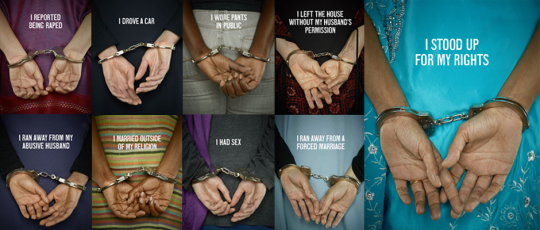
This class has really opened my eyes as to how women are treated around the world and the idea of intersectionality, the idea that women are treated differently than men but then also the idea that women of color and different backgrounds are being treated differently. I think this picture really represents many issues women have around the world and how they are dealt with not only because they are a woman but also based on their ethnicity and religion and race.
0 notes
Photo
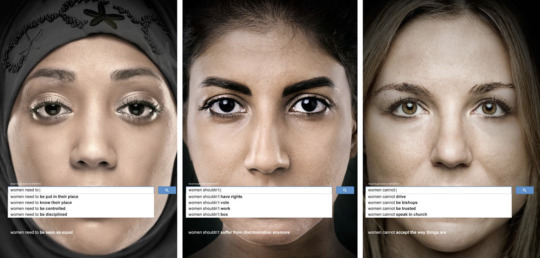
This picture really encapsulates everything we have been talking about in class and the idea of intersectionality. It shows how women of all different races and cultural backgrounds and people’s idea of what they need to do, what they shouldn’t be able to do, and what they can’t do or aren’t good at. This is the sad reality of what some people think and how women have been seen. Although in our society we have come far in women’s rights and equality. This is not the same around the world, like in third world countries, and these ideas of what women need to do or shouldn’t do is still very present. I think it is important that we understand that although all women face discrimination, every woman has different experiences with this based on their background.
0 notes
Photo


Feminism is the movement for social, political, and economic equality between women and men. But feminist beliefs, values, and practices must continually evolve to reflect change, because there is more to feminism than equality between men and women. Women are not treated fairly based on their religion, race, ethnicity, secuality and many more factors. This is the idea of intersectionality, and as it shows in the pictures on the signs, it is an important factor in femenism. Burn explains it as, “Gender is intersectional because the way it is enacted and experienced depends on the way it interacts with other social categories and identities” (Introduction to Global Women’s Studies page 8). Womesn issues neet to be seen differently and not just as a gender issue but and issue of many different category's people are seen as.
0 notes
Photo

Stereotypes are a big issue in this world, a stereotype is, an over-generalized belief about a particular category of people. It is an expectation that people might have about every person of a particular group. This relates to intersectionality because stereotypes of the different categories of people is what mostly makes people seem different and cause discrimination against one of these groups. An example of this is explained by Dalia Mogahed, in her Ted Talk, What it’s like to be Muslim in America. She is a Muslim women, who lives in America, she talks about the 9/11 attacks and how it was spread all over the news that it was a Muslim terrorist attack, Mogahed says, “not only had my country been attacked but in a flash somebody else’s actions had turned me from a citizen to a suspect.” This shows how stereotypes of people set them apart based on gender race, religion, ethnicity, etc.. and cause people to be seen different and discrimination around the world, a big factor into stereotypes is the media.
0 notes
Photo

Veiling is the Muslim custom of wearing hijab, this is often viewed by non-Muslim feminists as an oppressive act that silences Muslim women and exemplifies the myth of Islam as inherently sexist and patriarchal. As seen in this picture above it has caused many femnist women to think Muslim women wearing a veil need saving, yet these idea is not entirely accurate. Veiling can be a: symbol of faith/religious identity; symbol of modesty; sign of self-respect and / or of social status. For many Muslim women, wearing the headscarf is a feminist act, serving as a symbol of their identity and a way to counter cultural imperialism. Yet Muslims wearing a veil has created a lot of stereotypes in many western countries and they are sen as being opressed thing. Dalia Mogahed said in her Ted Talk, What it’s like to be Muslim in America, “One study found that 80 percent of news coverage about Islam and Muslim is negative.” This is an example of intersectionality because, even though these women wear veils, and are not oppressed, stereotypes from the media has cause many non-Muslim people to see it as being oppressed. This causes Muslim women to be seen different not only because they are a woman but also because of their culture and religion.
0 notes
Photo
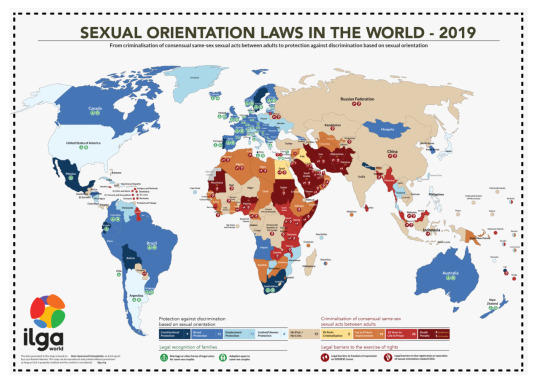
During this class we have talked about how same sex marriages are prohibited in Nigeria and people in the LGBTQ community not only face legal challenges but also social challenges. Violence against LGBTQ people is frequent there too. I looked more into the laws around the world about sexual orientation because I was curious if any other countries were like Nigeria. This picture caught my eye, it shows the sexual orientation laws around the world in 2019. It shows which countries have protection against discrimination based on sexual orientation, and the amount of protection there is. It also shows which countries consider it illegal and the punishment if caught. This was very eye opening to me to see how much of the world considers same-sex sexual acts to be a crime and prohibits same sex marriage. In some places you can even be given the death penalty. Although on June 26, 2015 the United States legalized same sex marriage in all 50 states, we need to realizes and other places where same-sex marriage is legal and there is protection for LGBTQ people, not every country is the same and everyone should be more educated on this and help fight for other people’s rights, so that everyone can eventually, be accepted around the world, legally and socially. This also plays into the idea of intersectionality because even though the US legalized same sex marriage doesn’t mean people accept it or think it’s right, there are hate crimes against it in the United States. This shows that strait women are not treated equally to women apart of the LGBTQ community and even though it is legal, in some places there is still more to be done because they are not treated equally.
0 notes
Photo
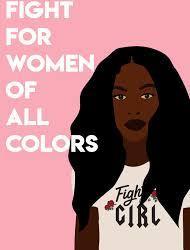
Women of color are not only discriminated based on their gender but also their race. Kimberlé Crenshaw explains intersectionality within gender and racism in her story, Mapping the Margins. The one of the things she said that stood out to me the most about this issue is, “I consider how the experiences of women of color are frequently the product of intersecting patterns of racism and sexism, and how these experiences tend to not be represented with in the discourse of either feminism or antiracism. Because of their intersectional identity as both women and in color within discourses that are shaped to respond to one or the other, women of color are marginalized as both” (page 201). Antiracism and feminism are big issues going on in the world right now, but they are seen in separate ways. Crenshaw is explaining here that women of color experience racism and gender inequality different than a man of color or a white woman. When women were fighting for their rights to vote, white women were able to vote in 1920, while women of color were not able to vote until 1965. This shows that not all women are the same and there is more to gender inequality than being a woman, and that is where the idea of intersectionality plays in.
0 notes
Photo

This picture represents intersectionality, not only does it represent gender inequality but also racial inequality. Gender inequality is represented by men making more money in the picture, in many places’ men will make more money than women for doing the same job, this shows how men and women were not treated equally. Within women not making as much money as men, women of color would make less than a white woman for doing the same job. This shows intersectionality because there is more to women’s rights than just gender. We not only need to be fighting for women’s equality to men but also women’s equality with race, ethnicity, background, culture, ect…
0 notes
Photo

This picture shows many factors that play into the idea of intersectionality. This idea is about all of these overlapping categories of a person’s social identity combined and how they impact people’s lives. Intersectionality is not only about “counting identities” or about separating women from one another. It is a sociological theory that centers around analyzing and discussing how identities intersect, creating unique and varied experiences of discrimination. We may have human “traits” in common, but it’s important to see difference because these differences impact how women experience oppression and discrimination differently.
0 notes
Photo
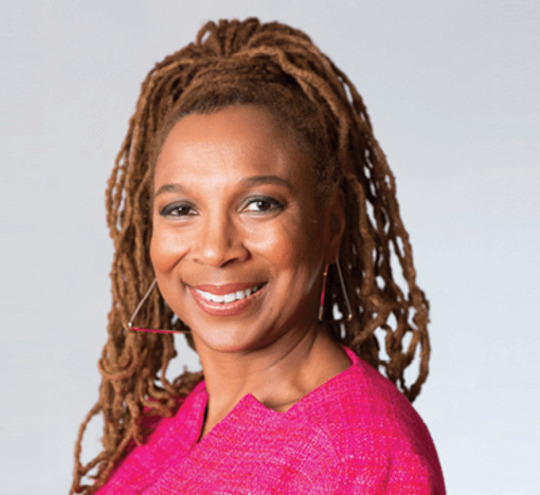
The term intersectionality comes from a Women named Kimberlé Crenshaw; she explains this idea in a story called Mapping the Margins. She defines intersectionality as, “The idea that we experience life, sometimes discrimination, sometimes benefits, based on a number of identities.” This concept advocates that many people are often disadvantaged by multiple sources of oppression, like, their race, class, gender identity, sexual orientation, religion, ect… It is more than just gender inequality that affects women around the world. This idea is very important for everyone to understand and learn more about because by understanding intersectionality it can help make people around the world all be treated equally, which is what many people have been fighting for.
0 notes